You'll need your meat to reach 165°F in a sunlight cooker to kill harmful bacteria and guarantee food safety, just like with traditional cooking methods. This temperature is especially critical for poultry and ground meats, as dangerous pathogens can survive at lower temperatures. Solar cooking requires careful monitoring since temperatures can fluctuate based on sunlight intensity and cooking conditions. Always use a reliable meat thermometer inserted into the thickest part of the meat, avoiding bones and fat, to verify safe cooking temperatures. Understanding proper temperature control and cooking techniques will help you master safe solar cooking practices.
Understanding Solar Cooking Temperature Requirements

While traditional ovens offer predictable heating, solar cookers require careful attention to temperature requirements for safe and effective cooking.
You'll need to verify your solar cooker reaches at least 180°F to begin cooking, though the ideal range for food safety is between 200°F and 300°F.
Your choice of solar cooker affects the maximum temperature you can achieve. Box cookers typically reach 325°F to 350°F, while parabolic models can exceed 500°F.
To maintain these temperatures, you'll need proper insulation, dark-colored cookware, and strategic timing. Using good insulating materials like newspapers and cotton balls helps trap thermal energy effectively. The best cooking window is between 10:00 AM and 2:00 PM when sunlight is most intense.
Remember to monitor your food with a reliable thermometer and adjust the cooker's position to track the sun for consistent heating.
Bacterial Growth in Sunlight Cookers
Although sunlight naturally inhibits bacterial growth through UV radiation, proper temperature control in your solar cooker remains crucial for food safety. While UV rays can reduce bacterial populations to 6.8% compared to dark conditions, you'll need consistent heat to guarantee complete food safety. Research shows that dark-loving bacteria thrive in environments with minimal light exposure, making proper sunlight exposure essential for food preparation.
| Cooking Factor | Impact on Bacteria | Safety Measure |
|---|---|---|
| Direct Sunlight | Reduces viability to 6.8% | Position cooker for maximum exposure |
| UV Radiation | Damages cell membranes | Use reflective surfaces to increase UV |
| Temperature | Kills bacteria at 165°F | Monitor with food thermometer |
| Time | Longer exposure = more reduction | Cook until proper temperature reached |
Remember that sunlight alone isn't enough to make meat safe. Even though solar radiation disrupts bacterial cell functions, you'll need to maintain proper cooking temperatures to effectively eliminate harmful microorganisms in your food.
Safe Internal Temperature Guidelines

You'll need to monitor three critical temperature zones in your sunlight cooker: the cold zone below 40°F, the danger zone between 40-140°F, and the safe cooking zone above 140°F.
Using a reliable meat thermometer is essential for ensuring food safety and preventing foodborne illness. Your food thermometer must be placed in the thickest part of the meat, away from bones and fat, to get an accurate reading of the internal temperature.
To guarantee harmful bacteria are eliminated, follow specific temperature requirements based on meat type:
- 165°F for poultry and stuffed meats,
- 160°F for ground meats,
- 145°F with a rest period for whole cuts.
Temperature Zones Matter Most
Understanding temperature zones represents the cornerstone of food safety when cooking meat.
You'll need to keep your meat out of the danger zone, which spans from 40°F to 140°F, where bacteria thrive and multiply rapidly.
Once you've cooked your meat, you've got a two-hour window to refrigerate it before bacteria levels become unsafe.
When you're using a sunlight cooker, you must guarantee your meat reaches proper internal temperatures.
You'll want to hit 165°F for poultry and reheated meats, 160°F for ground meats, and 145°F for whole cuts followed by a three-minute rest.
If your meat sits at room temperature beyond two hours or at 90°F for one hour, you'll need to discard it to prevent foodborne illness.
Thermometer Placement and Testing
Proper thermometer placement serves as the key to achieving safe meat temperatures in sunlight cookers.
You'll need to insert your thermometer into the thickest part of the meat, about an inch deep for thick cuts and half an inch for thinner pieces, while avoiding bones, fat, or gristle.
When testing meat in your sunlight cooker, verify poultry reaches 165°F (75°C), ground meats hit 160°F (70°C), and whole cuts reach 145°F (65°C).
You'll want to take multiple readings to confirm accuracy – wait at least 10 seconds after inserting the probe for each reading.
Don't rely on the meat's color to determine doneness. Instead, check each piece individually by inserting the thermometer through the side for thinner cuts like hamburgers or chicken breasts.
Bacteria Die-Off Points
Since bacterial growth occurs rapidly between 40°F and 140°F (4°C-60°C), maintaining safe internal temperatures is vital for killing harmful microorganisms in your sunlight cooker.
You'll need to guarantee your poultry reaches 165°F (74°C), while ground meats must hit 160°F (71°C). For whole cuts of meat and seafood, aim for 145°F (63°C). If you're reheating leftovers, bring them back to 165°F (74°C) for safety.
While you can use lower temperatures, you'll need to maintain them longer. For instance, chicken at 136°F (58°C) requires 64 minutes of sustained heat.
Remember that some bacteria form heat-resistant spores, so following these temperature guidelines is essential. Even after freezing, bacteria can revive when thawed, making proper cooking temperatures your best defense against foodborne illness.
Sunlight Cooking Time Variables
When cooking with a solar oven, multiple variables affect how quickly your food will reach the desired temperature. The most significant factor is the intensity of direct sunlight, which peaks two hours before and after solar noon. You'll achieve the best results when the outside temperature is above 75°F and there's minimal cloud cover.
Your cooker's design plays a vital role too. Parabolic cookers concentrate sunlight more effectively than box-type models, leading to faster cooking times. You'll need to reorient your cooker every 20-30 minutes to maintain ideal sun exposure.
Keep in mind that larger cuts of meat take longer to cook than smaller portions. For consistent results, use dark, matte-finished cookware that absorbs heat efficiently, and avoid letting shadows from nearby objects block the sunlight.
Temperature Monitoring Methods
You'll find digital thermometers offer more precise readings than their analog counterparts when monitoring meat temperatures in your solar cooker.
For accurate measurements, insert the probe into the thickest part of the meat, away from bones or fat, and wait until the reading stabilizes.
Your thermometer needs regular calibration using either the ice-water or boiling-water method to maintain its accuracy and guarantee food safety.
Digital Vs Analog Devices
As solar cooking technology advances, choosing between digital and analog temperature monitoring methods becomes a crucial decision for achieving precise meat cooking temperatures.
Digital devices offer clear advantages for sunlight cookers – they're more reliable, provide accurate readings regardless of wire length, and aren't affected by environmental noise that could compromise your cooking results.
While analog devices are cheaper, they'll require additional components and careful calibration to work effectively. You'll need an analog-to-digital converter and extra circuitry, which adds complexity to your setup.
In contrast, digital sensors connect directly to your monitoring system through standard protocols like I2C or SPI.
For ensuring meat safety at 165°F, digital monitors are your best choice. They'll give you guaranteed accuracy right out of the box and maintain consistent readings despite varying sunlight conditions.
Probe Placement Techniques
Proper probe placement in sunlight cookers determines the success of your meat cooking endeavors.
You'll need to insert the probe into the thickest part of your meat, avoiding any bone or fat that could give false readings. When cooking poultry, verify you're reaching the innermost part of the breast or thigh.
For continuous monitoring, you can use a thermometer with a heat-resistant cable or opt for a wireless device that connects to your smartphone. This allows you to track temperatures without opening the cooker and losing heat.
Remember to clean your probe between readings to prevent cross-contamination, and wait for the reading to stabilize before recording the temperature.
You'll want to maintain temperatures above 140°F for safety, with poultry reaching 165°F and ground beef hitting 155°F for 15 seconds.
Calibration Best Practices
Beyond accurate probe placement, ensuring your temperature monitoring tools are correctly calibrated forms the foundation of reliable cooking measurements. You'll need to verify your thermometer's accuracy within 10°F (6°C) of the target reading. For digital thermometers, follow your manual's specific calibration instructions, which often require pressing button combinations to enter calibration mode.
| Calibration Step | What You Need to Do |
|---|---|
| Initial Check | Test thermometer in ice water (32°F/0°C) |
| Adjustment | Follow manual to enter calibration mode |
| Verification | Test in boiling water (212°F/100°C) |
| Documentation | Record date of calibration for tracking |
For analog thermometers, rotate the notched disk beneath the display to adjust readings. If you can't achieve accurate calibration after multiple attempts, it's time to consult a certified technician or replace your device.
Solar Heat Distribution Patterns
When solar radiation hits a cooker's surface, distinct heat distribution patterns emerge that directly impact cooking effectiveness.
You'll notice that temperatures peak between 11:00 am and 3:00 pm, when solar radiation reaches its maximum of about 881.2 W/m². During this period, your cooker can achieve ideal cooking conditions.
The heat distribution pattern relies on several key factors:
- Reflector positioning that concentrates sunlight onto your cooking surface
- Insulation quality that prevents heat from escaping through the walls
- Thermal mass materials that store and distribute heat evenly
- Environmental conditions like altitude and cloud cover that affect radiation intensity
Your cooker's design must balance these elements to maintain consistent temperatures.
With proper heat distribution, you'll see temperatures of up to 64°C in water and 52°C in the cooking box during peak hours.
Meat Safety Risk Factors

When you're cooking meat in a sunlight cooker, you'll need to monitor temperatures carefully to avoid the bacterial growth danger zone between 40°F and 140°F (4°C-60°C), where harmful pathogens multiply rapidly.
You must prevent cross-contamination by keeping raw meat separate from other foods and using dedicated utensils for handling uncooked proteins.
Your raw meat storage practices are equally critical, requiring proper refrigeration below 40°F (4°C) before cooking and maintaining clean, sealed containers to prevent bacterial spread.
Bacterial Growth Danger Zone
Although proper cooking methods are essential for solar cookers, understanding the bacterial growth danger zone is equally critical for meat safety.
Bacteria thrive between 4°C and 60°C (40°F and 140°F), with the most dangerous range being 21°C to 47°C (70°F to 117°F). In these conditions, bacteria can double every 20 minutes, putting your food at serious risk.
When handling meat, you'll need to be particularly vigilant about these high-risk pathogens:
- Campylobacter, commonly found in raw poultry
- Salmonella, present in raw eggs and meats
- Listeria, which can contaminate pre-packaged foods
- Other harmful bacteria that cause foodborne illness
To prevent bacterial growth, you must move meat through the danger zone quickly when heating or cooling.
Always verify your sunlight cooker reaches at least 74°C (165°F) for 15 seconds to kill harmful pathogens.
Cross-Contamination Hazards
Cross-contamination poses a serious threat to meat safety in sunlight cooking, particularly since bacteria can spread through multiple pathways.
You'll need to be vigilant about three main transmission routes: food-to-food, people-to-food, and equipment-to-food contact.
Don't let raw meat juices drip onto other ingredients, and keep your raw meat separate from ready-to-eat foods in your prep area.
You must wash your hands thoroughly with warm, soapy water before and after handling raw meat.
Never use the same cutting boards or utensils for raw meat and other foods without proper cleaning first.
It's smart to use a color-coded system for your cutting boards – red for meat and green for vegetables.
Raw Meat Storage Risks
Storing raw meat properly is essential to prevent dangerous foodborne illnesses. When you don't maintain proper refrigeration temperatures between 38-40°F, harmful bacteria like E. coli, Salmonella, and Listeria can multiply rapidly.
This contamination risk is especially high with ground meats due to extensive handling during processing.
Your meat's nutritional value also suffers from improper storage, leading to:
- Loss of crucial vitamins and minerals
- Degradation of protein quality
- Changes in color and texture
- Accelerated spoilage and waste
To protect yourself, always store raw meat in airtight containers or sealed wrapping to prevent leaking juices. Keep it separate from ready-to-eat foods, and never thaw meat at room temperature.
Remember that spoiled meat isn't just a financial loss – it's a serious health risk that can lead to severe food poisoning.
Weather Impact on Cooking
Weather conditions play an important role in how effectively your solar oven will cook meat.
You'll need to account for cloud cover, wind, and seasonal changes to guarantee your meat reaches the safe temperature of 165°F.
On cloudy days, you'll experience longer cooking times, so it's vital to use a well-insulated solar oven with heat-retention features.
Wind can greatly reduce your cooking temperature, so place your cooker in a sheltered spot and consider using thermal mass like rocks to maintain heat.
During winter months, you'll need to adjust your oven's angle more frequently and cook during peak hours (11 am to 3 pm).
For best results, cook on days when the ambient temperature is around 77°F, and use additional insulation and reflective surfaces to maintain consistent cooking temperatures, regardless of weather conditions.
Thermometer Placement During Solar Cooking
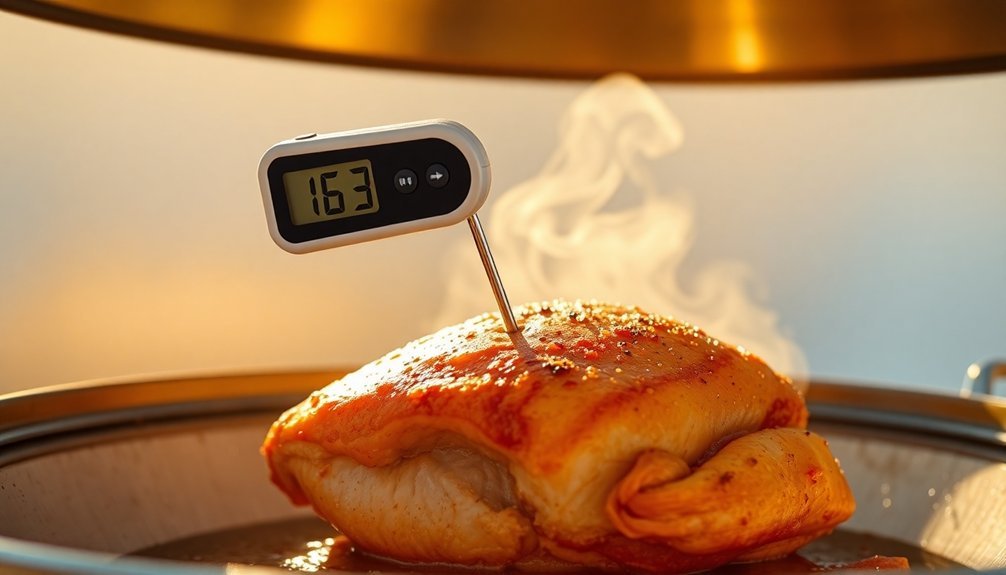
Proper thermometer placement serves as the foundation of safe and effective solar cooking. You'll need to position your thermometer in the thickest part of the meat while making sure it doesn't touch the cooker's sides or bottom, which could give false readings.
For ideal temperature monitoring during solar cooking, you should:
- Choose a digital probe thermometer that can withstand temperatures up to 300°C
- Position the probe in the center of your food
- Check readings every 20 minutes
- Calibrate your thermometer regularly for accuracy
You'll want to maintain temperatures between 200°F and 300°F, adjusting your cooker's position as needed throughout the day.
Optimal Solar Cooking Conditions
To achieve successful results with solar cooking, you'll need specific environmental conditions and proper equipment setup.
For best results, cook between 10 a.m. and 2 p.m. when the sun is highest, providing maximum sunlight exposure. You'll want clear, sunny days without cloud cover to reach ideal temperatures.
Your location matters considerably – if you're closer to the equator, you'll benefit from more direct sunlight. At higher latitudes, you'll need to adjust your cooker's angle to capture more sun rays.
Use dark-colored pots (not cast iron) and enhance efficiency with reflectors. Don't forget to add a transparent heat trap like an oven bag.
Place your cooker on level ground away from shadows, and remember to check it periodically, adjusting its position to maintain direct sunlight exposure.
Danger Zone Prevention Strategies
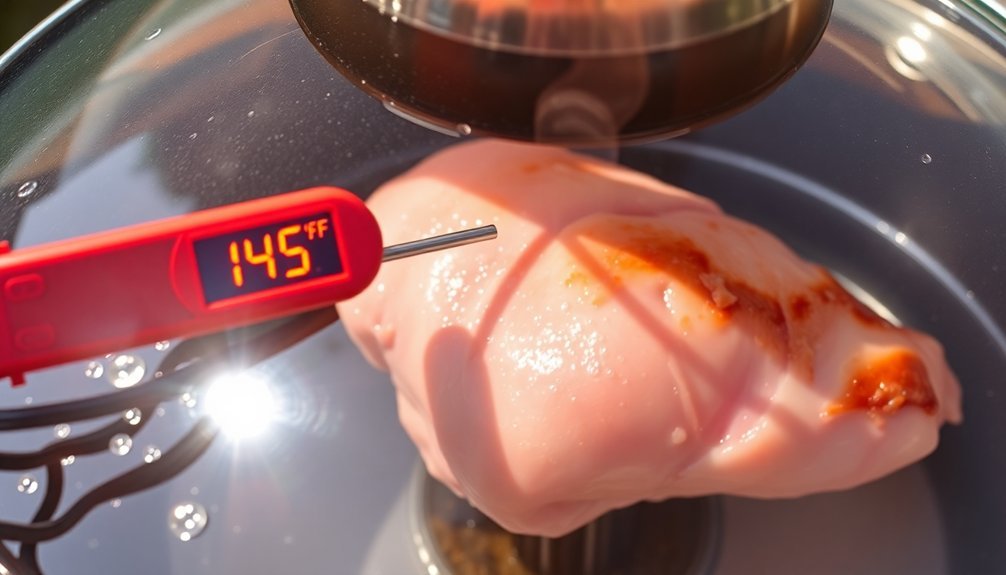
While solar cooking offers an eco-friendly cooking method, maintaining safe food temperatures remains a top priority. You'll need to monitor your meat carefully to prevent it from lingering in the danger zone between 41°F and 135°F, where bacteria multiply rapidly.
To keep your solar-cooked meat safe, follow these essential strategies:
- Check internal temperatures frequently using a reliable meat thermometer
- Don't let partially cooked meat sit at ambient temperature
- Cover your solar cooker to maintain consistent heat
- Ascertain meat reaches 165°F quickly and stays above 135°F until serving
If you can't maintain proper temperatures due to insufficient sunlight or weather changes, transfer the meat to a conventional heat source to complete cooking.
Proper Food Handling Techniques
Safe food handling serves as the foundation for successful solar cooking, just as it does for conventional cooking methods.
You'll need to follow key practices across four critical areas: clean, separate, cook, and chill.
Start by washing your hands thoroughly with warm soapy water for at least 20 seconds before handling any food.
Keep raw meats separated from other ingredients to prevent cross-contamination, and use dedicated cutting boards for raw foods.
When cooking, you must guarantee your meat reaches proper internal temperatures – 165°F for poultry, 155°F for ground meats, and 145°F for fish.
Don't rely on visual cues alone; always use a food thermometer.
Once cooked, promptly store leftovers in your fridge at 40°F or below, and cool hot foods within 2 hours to prevent bacterial growth.
Solar Cooking Safety Precautions
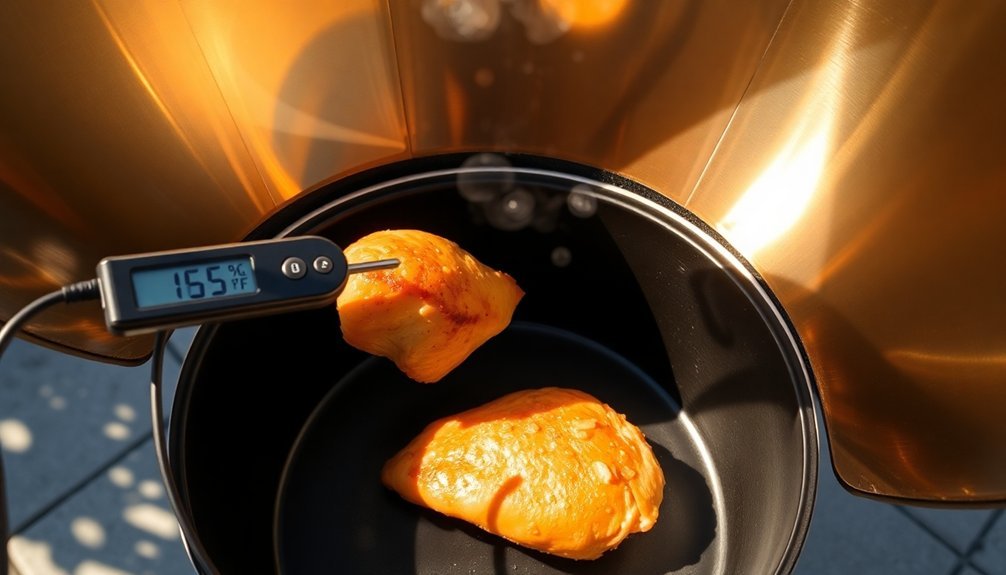
Since solar cooking involves intense sunlight and concentrated heat, proper safety measures are essential to prevent accidents and guarantee food safety.
You'll need to position your cooker on level ground and wear protective gear, including sunglasses and heat-resistant gloves when handling equipment.
For safe operation, always follow these critical precautions:
- Keep children at a safe distance to prevent eye damage and burns
- Turn the mirror face-down when not in use to protect it from elements
- Never look directly into the focal area of parabolic cookers
- Test your cooker's performance regularly for temperature consistency
Remember to monitor cooking temperatures with a calibrated thermometer, ensuring meat reaches 165°F to kill harmful bacteria.
If weather conditions become unfavorable, don't hesitate to finish cooking with an alternative heat source to maintain food safety standards.
Frequently Asked Questions
Can Sunlight Cookers Sterilize Contaminated Meat That Was Improperly Stored?
No, you shouldn't rely on sunlight cookers to sterilize contaminated meat. They can't consistently maintain the high temperatures needed for proper sterilization, and improperly stored meat poses serious health risks that solar cooking won't eliminate.
How Does Altitude Affect Cooking Temperatures in Solar Cookers?
At higher altitudes, you'll get stronger solar radiation but lower air temperatures. Your solar cooker's performance balances these factors – more intense sunlight helps cooking, while cooler air increases heat loss from the device.
Does Meat Color Change Differently in Sunlight Cookers Versus Conventional Ovens?
You'll notice meat color changes the same way in both sunlight cookers and conventional ovens. The color transformation is driven by temperature and oxidation, not the light source or cooking method you're using.
Can Solar Cookers Maintain 165°F During Partial Cloud Coverage?
Yes, you'll find that solar cookers can maintain 165°F during partial clouds. With proper insulation and thermal mass, your cooker will sustain 200-250°F, even when clouds reduce efficiency to 50-80% of peak performance.
Do Different Types of Cooking Vessels Affect Meat Temperature in Sunlight Cookers?
Yes, your cooking vessel choice greatly impacts meat temperature. You'll get better results with dark-colored, heavy-duty pots that have tight-fitting lids, as they retain heat longer and distribute it more evenly.
In Summary
You'll need to verify your solar-cooked meat reaches 165°F to kill harmful bacteria and pathogens that can thrive in the temperature danger zone. By maintaining this minimum safe temperature, you're protecting yourself from foodborne illness. Don't rely on appearance alone – always use a meat thermometer and follow proper food handling guidelines when cooking with solar energy to guarantee your meal is safe to eat.
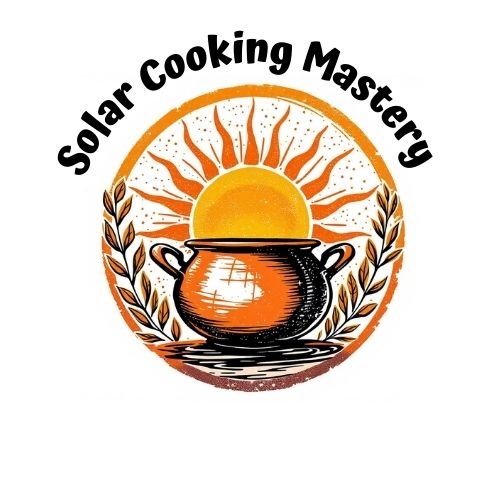

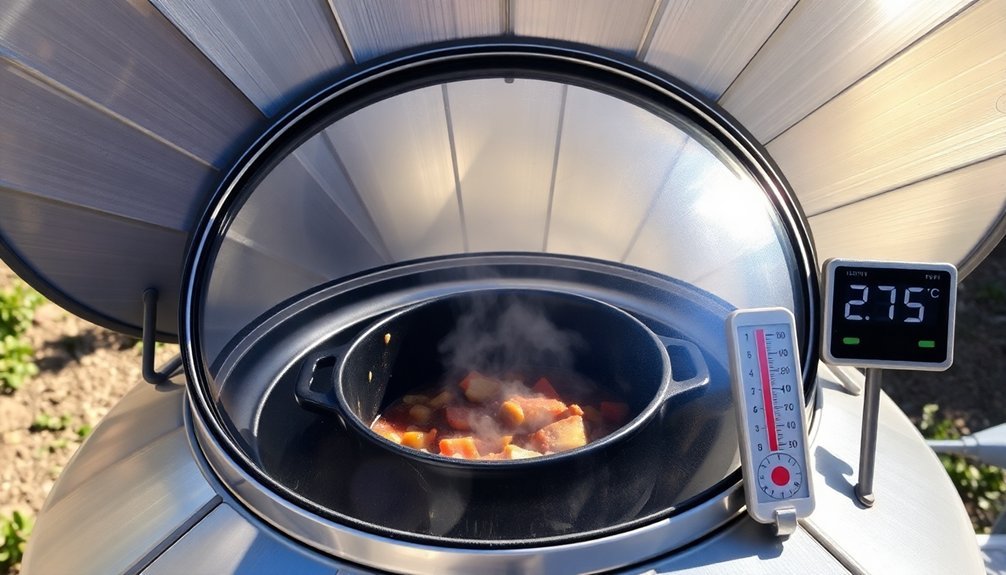


Leave a Reply